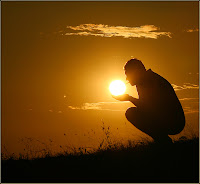Have you heard about DSPS (delayed sleep phase syndrome)? Many haven't. But if you've watched the truly hilarious video I posted above, then you know there are companies out there acutely aware of DSPS and actively developing products to help combat the problem. We here at Insomnia cures have taken up the cause as well, delving into the research and potential benefits of the treatment for DSPS, which is divided between antidepressants and light therapy.
To understand how light therapy works, one has to understand the effects of light on our overall well being. And before you write off light therapy as "just another useless toy", do note that The National Sleep Foundation endorses the use of these machines, they publish a guide titled "Managing Light for Better Sleep", and they work closely with Philips products such as the Philips Energy Light.
Many of us who live in cold or wet climates often fall victim to "Seasonal Affective Disorder", known as SAD (truly an appropriate acronym). SAD has been related to a lack of serotonin production, in which cases anti depressants such as Fluoxetine have been shown beneficial in treatment, since the drug increases the amount of the enzyme Serotonin N-acetyltransferase, resulting in an antidepressant-like effect. Most people suffering SAD or SSAD (Subsyndromal Seasonal Affective Disorder) simply fall victim to the lack of solar, light, and UV exposure. Somehow the body reacts to a lack of appropriate daily light by retarding the production of many of the hormones and chemicals we need to feel vibrant and experience normal emotive responses.

Long story short, since I truly don't want my site to turn into a text book, SAD can be treated with light therapy, and has been used effectively as one of many insomnia cures that that become necessary as a result of SAD. How it works might seem simple enough, but there has been numerous research done to dig into the deeper answers for why light therapy is beneficial to the insomnia patient and the person suffering seasonal depression.
How Does It Work to Cure Insomnia?
- Exposure to light activates neuro-endocrine processes in the body. The main receptors for light absorption exist through the eyes and the skin. Such processes include regulating the production of hormones and chemicals that are shown as deficient in certain insomnia problems, as well as SAD patients. As such, these chemicals are the body's own sleep agent, and any increase in their production results in less occurrences of insomnia
- Biophotonics is the study of biophotons emitted by biological cells, and has proven that cells communicate via biophotons. Simply put, our cells emit light and receive light as part in parcel of the physiological process of symbiotic communication with the world we live in. This field of research has therefore shown by empirical evidence that our bodies, down to our very cells, react and co-mingle with light to benefit our well being. By increasing the exposure to light at certain times of the day, you are communicating to the body's natural rhythms, telling it when it's own natural relaxation/wind down process should occur.
- Night Owl Insomnia - The layman's term for DSPS. This process is when the person is seeking insomnia cures due to severe trouble winding down to sleep until very late in the evening. This syndrome usually forms in the teens and results in a maladjusted body rhythm that fails to recognize late night as the time for resting. Here is where light therapy has proven to be most effective. By exposure to light therapy for 2 hours in the morning, along with a restriction from bright light in the hours after dusk, light therapy successfully re-calibrates the circadian rhythm and induces sleep at much earlier hours.
- Harvard Research has concluded that light therapy is a meaningful and highly successful treatment, with documented positive results in their own sleep tests. Yes. Harvard. So folks, don't take my word on it. Look to the world's most esteemed research University. Harvard has publicly stated that some Light Therapy products work in over 86% of their own instances of applied research. And folks, they didn't study normal insomnia victims, they were studying astronauts on the International Space Station. I think it's pretty safe to assume you can trust that research. :)
In closing I feel it necessary to add that my research into light therapy was strictly based on it's application as one of many insomnia cures; but what I discovered is that light therapy has many health benefits completely not related to sleep cycles. It benefits moods and dispositions, it increases the body's production of the hormones and chemicals we require to be as healthy as we can. It has shown marked improvement in a person's daily energy levels. In fact the list of things that light therapy can do to cause improvement in overall health is rather breathtaking.
So I strongly suggest that anyone thinking about it should get a light therapy machine. In the grand scheme of things it's not expensive. You can click here to get Philips most promising machine, at a significant discount from store bought prices.
